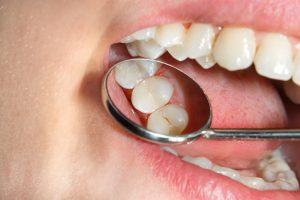Tooth-Colored Fillings in Fort Worth, TX
Restore Your Smile Without Sacrificing its Beauty
 For those struggling with cavities or tooth decay, tooth-colored fillings present an optimal solution, not only for restoring your smile’s aesthetics but also for preserving its functionality. Unlike traditional silver fillings, composite fillings offer advantages that elevate their appeal.
For those struggling with cavities or tooth decay, tooth-colored fillings present an optimal solution, not only for restoring your smile’s aesthetics but also for preserving its functionality. Unlike traditional silver fillings, composite fillings offer advantages that elevate their appeal.
At Lake Country Dental, Dr. Ray Snider and our team take pride in providing resilient, lifelike composite resin fillings that safeguard and rejuvenate your teeth. Continue reading or call 817-236-8771 to learn more.
What Are Composite Dental Fillings?
Traditionally, amalgam fillings served as the go-to solution for cavities. While effective for some, their propensity to wear down and silver appearance left many dissatisfied.
Tooth-colored fillings are a revolutionary alternative employing composite resin to restore decayed teeth. Tailored to seamlessly blend with your natural tooth in size, shape, and color, these fillings don’t use mercury, ensuring both your tooth and oral health remain uncompromised.
Benefits of Composite Dental Fillings
There are several benefits of composite tooth fillings, including:
- Aesthetic Appeal: Composite fillings are highly customizable in color, allowing them to match the natural shade of your teeth. Unlike traditional silver amalgam fillings, composite fillings blend seamlessly, enhancing the overall appearance of your smile.
- Preservation of Tooth Structure: Composite fillings require less removal of the natural tooth structure. This preservation is beneficial for the long-term health of the tooth, as it maintains more of the healthy enamel.
- Durability: Composite fillings are strong and durable, capable of withstanding the regular forces of chewing and biting. This durability ensures that the filling remains intact and functional for an extended period, providing reliable support to the affected tooth.
- Versatility: Composite fillings can be applied to fill cavities in different areas of the mouth, offering a versatile solution for tooth restoration.
- No Mercury: Unlike silver amalgam fillings, composite fillings are mercury-free. This characteristic makes them a safer alternative for individuals concerned about potential mercury exposure.
Candidacy for Composite Dental Fillings
 Consider composite dental fillings if you:
Consider composite dental fillings if you:
- Have small to medium-sized cavities or require filling replacement.
- Prefer a filling that matches the natural color of your teeth.
- Seek a less invasive option that preserves more of your natural tooth structure.
- Are looking for a filling in visible areas of your mouth where aesthetics matter.
Composite dental fillings offer both aesthetic and functional advantages, particularly for individuals seeking a more natural-looking option while maintaining the integrity of their teeth. Call 817-236-8771 to learn more.
The Composite Dental Fillings Process
Anesthesia Administration
Before starting the procedure, Dr. Snider administers a localized anesthetic to ensure a painless experience for the patient. This numbs the area around the affected tooth, minimizing any discomfort during the filling process.
Decay Removal and Preparation
The dentist removes the decayed or damaged portion of the tooth using specialized dental instruments. This step involves meticulous cleaning and shaping new filling of the cavity to prepare it for the filling.
Composite Resin Application
Once the tooth is adequately prepared, the dentist applies the composite resin in layers into the cavity. Each layer is meticulously placed and shaped to ensure a precise fit and natural appearance. The resin material matches the color and texture of the natural tooth.
Bonding and Curing
 Following the resin application, a special light, often an ultraviolet (UV) light, is used to harden or cure the composite filling material. This curing process helps the resin bond securely to the tooth structure, ensuring durability and strength.
Following the resin application, a special light, often an ultraviolet (UV) light, is used to harden or cure the composite filling material. This curing process helps the resin bond securely to the tooth structure, ensuring durability and strength.
Shaping and Polishing
After the composite resin is cured, Dr. Snider will shape and refine the composite filling to achieve the desired contour and alignment with the natural tooth. The filling is polished to a smooth finish, enhancing its appearance and preventing premature staining or wear.
Bite Assessment and Adjustment
Your Fort Worth dentist evaluates the patient’s bite to ensure the filling aligns correctly with the opposing teeth. Any necessary adjustments are made to the filling materials to ensure proper occlusion and comfort during biting and chewing.
Aftercare for Composite Dental Fillings
Aftercare for composite dental fillings is essential to ensure their longevity and oral health. Here are some key aftercare tips:
- Maintain Good Oral Hygiene: Brush your teeth at least twice a day using fluoride toothpaste and floss daily. Proper oral hygiene helps prevent plaque buildup, decay, and gum disease, which can impact the longevity of the fillings.
- Avoid Staining Agents: Minimize consumption of staining agents such as coffee, tea, red wine, and tobacco. These substances can potentially discolor the composite fillings over time, affecting their appearance.
- Regular Dental Check-ups: Maintain routine dental visits for professional cleanings and check-ups. Your dentist can monitor the condition of the fillings, ensuring they remain intact and addressing any issues at an early stage.
- Avoid Teeth Grinding: If you grind your teeth (bruxism), consider using a mouthguard at night. Grinding can put undue pressure on the fillings, leading to premature wear or damage.
- Follow the Dentist’s Recommendations: Dr. Snider may provide specific instructions based on your oral health needs. Follow their guidance regarding aftercare, any prescribed medications, or additional precautions for optimal results.
Frequently Asked Questions
How long do tooth-colored fillings last?
Tooth-colored fillings, typically made of composite resin, can last around 10 to 12 years with proper care. However, their longevity can vary based on factors such as oral hygiene, the size of the filling, the location in the mouth, and chewing habits. Regular dental check-ups can help monitor the condition of the fillings and determine if any replacements or maintenance are necessary.
Does insurance cover the cost of tooth-colored fillings?
Many dental insurance plans cover the cost of tooth-colored fillings, similar to how they cover other types of fillings. Coverage for white fillings can vary depending on your specific insurance plan and policy. It’s advisable to check with your dental insurance provider to understand the extent of coverage for tooth-colored fillings.
Does getting tooth-colored fillings hurt?
During the procedure, the dentist typically administers a local anesthetic to numb the area being treated, ensuring that you feel minimal to no discomfort. Local anesthesia helps alleviate any pain or discomfort during the process of dental filling. Patients might experience some sensitivity or mild discomfort after the procedure, but this usually subsides within a few days.
Are tooth-colored fillings safe?
Yes, tooth-colored fillings, made of composite resin, are considered safe. They don’t contain mercury, which is a concern for some individuals with traditional silver amalgam fillings. Composite fillings have been used for many years and are deemed safe and effective for dental restorations. They offer a durable and aesthetically pleasing option for treating cavities while preserving natural healthy tooth structure throughout.
Fix Your Smile and Protect Your Teeth from Cavities
Entrust your dental care to our adept team at Lake Country Dental. Schedule an appointment with Dr. Snider by reaching out to our Fort Worth office at (817) 236-8771. Alternatively, visit our contact page to fill out an online form, and our team will promptly assist you in preserving your radiant smile. We also welcome patients from Arlington, Grand Prairie, and Irving.



 817-236-8771
817-236-8771





